CPU / GPU Performance Model based on Interval Analysis
简介
虽然这些模拟器不是cycle-accuracy的,但是最终误差距离cycle-accuracy竟然只有10%[^3]
Interval analysis
Interval analysis is a relatively accurate performance modeling technique, which traverses the instruction trace and uses functional simulators, e.g., cache simulator, to track the stall events that cause performance loss.[^1]
high Speed and better accuracy: It shows hundred times(97x) of speedup compared to detailed timing simulations and better accuracy compared to pure analytical models.[^1]
 [^4]
[^4]
Interval Model on CPU
CPU Model
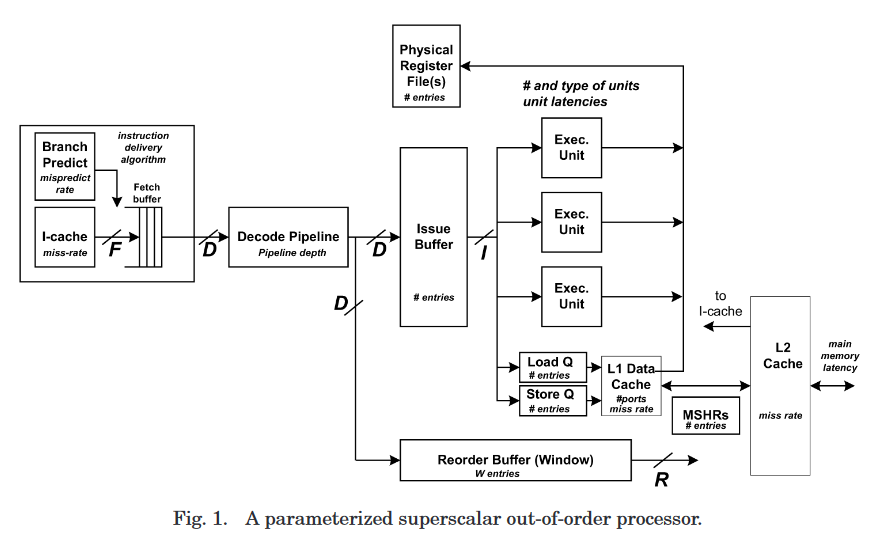 [^5]
[^5]
- fetch width
F, dispatch widthD, issue widthI, and retire widthR. ROB window sizeW - It is assumed that the front-end decode and rename pipeline stages match the dispatch width
D
Balanced Processor
Balanced Processor: OOO处理器如果对于给定的dispatch width D, ROB(window size)和其他资源(如the issue buffer(s), load/store buffers, rename registers, MSHRs, functional units, write buffers,等)的大小足以在没有miss event的情况下实现每个周期D条指令的持续处理器性能。
重点在于平衡:
- 其他资源(Buffer)变小,就吃不满dispatch width
D的带宽。 - 其他资源(Buffer)增大,也无法跨越dispatch width
D的限制。
Machine Balance
这与 95 年的计算访存的一个概念有些相似:[^7]
$$balance = \frac{peak floating ops/cycle}{sustained memory ops/cycle}$$
应用在app kernel 就是 compute indensity.
formula
$$Interval = N/D useful + penalty$$
- N : instruction number
- D : Dispatch width - refers to the movement of instructions from the front-end pipeline into the reorder and issue buffers.[^5]
- 发射(dispatch)到执行单元并执行的整个过程
- 在大部分CPU里,D都是最小宽度,F>D, I>D 。有时也叫
processor width
Dispatch Inefficiency.
ceiling function + “edge effect”:

Putting It Together: The Overall Model.

Example
Short Back-End Miss Events
- L1 D-cache miss
- miss latency can be hidden by out-of-order execution
Long Back-End Miss Events.
miss from the L2 cache to main memory,
长延迟会依次导致:
- ROB fill
- dispatch stalls
- issue and commit cease
miss data 读取到之后,依次发生:
- ROB unlocked
- dispatch resumes
导致
load miss的指令,要依次- 先fetch到
decode buffer。 - 再dispatch到
issue buffer - 最后issue到
load unit,来访问memory
- 先fetch到
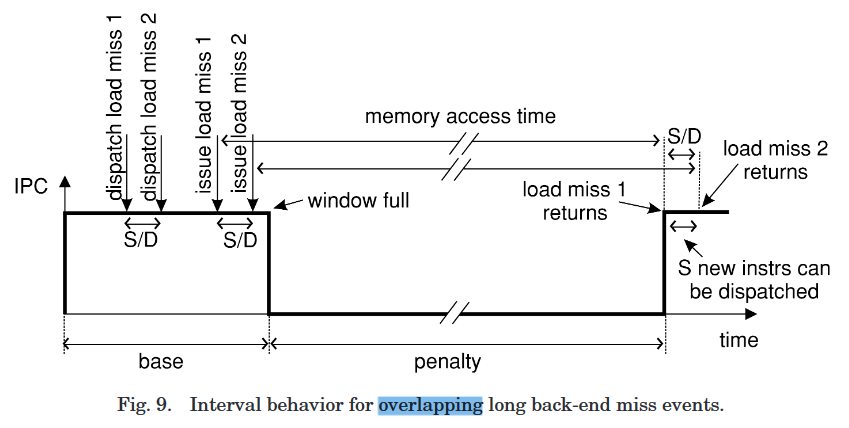
Interval Model on GPU
Baseline
Penalty 1 : Sub-core model
Consider Warp Switch to hide latency[^1] [^2]
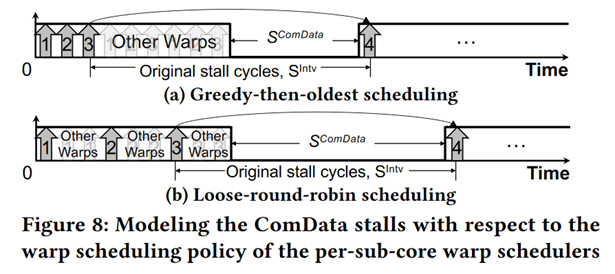
Penalty 2 : Intra-SM Contention
FU, L1 bank limited [^3]
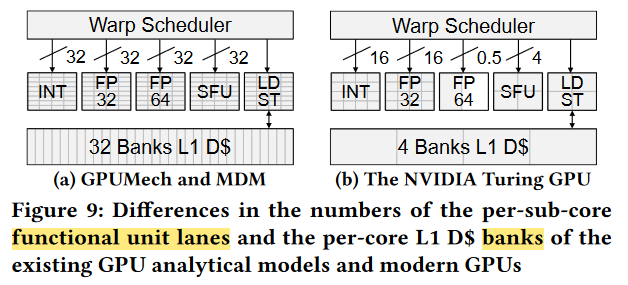
Penalty 3 : Memory contention
memory divergence,L1 MSHR Full,NoC, DRAM queue[^2]
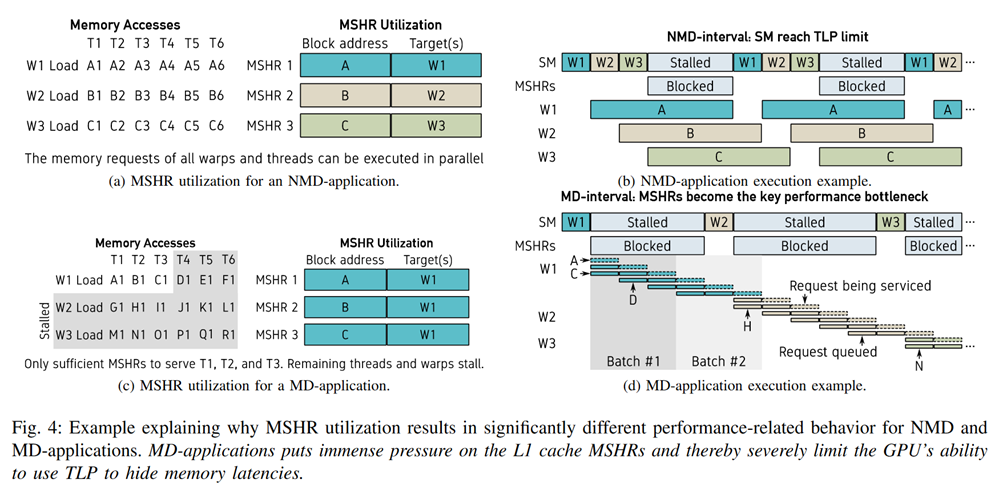
Penalty 4 : SM Load Imbalance
Some Warp fast, some slow.[^3]
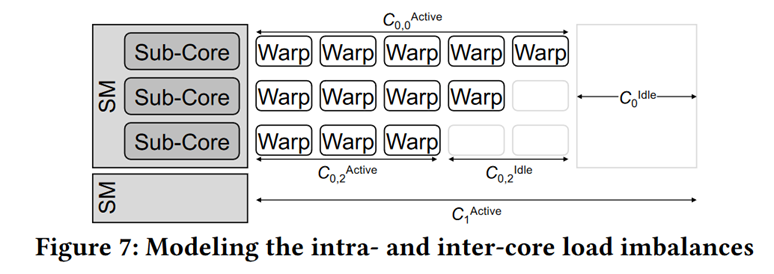
CPU vs GPU model
Mechanistic Performance Model 是根据物理设计结构来模拟的。
由于GPU的sub-core(warp-scheduler)相对于CPU简单,所以能用公式抽象出来:
- base IPC = 1,Don’t consider frontend stall
- In-order execute
读论文时的疑问,需要回答的问题
GPUMech
- 之前的GPU performance model 聚焦于 应用优化,而不是 DSE。这些分析模型的不同
- CPU的Interval Model和GPU的有何不同,两者的区别?
- CPU侧的几个假设:
- Under optimal conditions (no miss events), the processor sustains a level of performance more-or-less equal to its pipeline front-end dispatch width
- front-end pipeline , the reorder buffer and issue queues.
- CPU侧的几个假设:
研究路径分叉点
Analytical Model
- CPU
- (JPDC91) An analytical approach to performance/cost modeling of parallel computers.
- (MICRO94)Theoretical modeling of superscalar processor performance.
- (HPCA09) A First-Order Fine-Grained Multithreaded Throughput Model
- GPU
- (ISCA ’09.) An analytical model for a GPU architecture with memory-level and thread-level parallelism awareness.
- (PPoPP10) An adaptive performance modeling tool for gpu architectures.
- (HPCA ’11) A quantitative performance analysis model for GPU architectures.
- (PPoPP ’12) A performance analysis framework for identifying potential benefits in GPGPU applications.
CPU侧
- KARKHANIS,T.,AND SMITH的5篇 interval analysis 相关的文章
- (ISCA04) A first-order superscalar processor model.
- (ASPLOS’06) A performance counter architecture for computing accurate CPI components
- (ISPASS06) Characterizing the branch misprediction penalty.
- (ISCA07) Automated design of application specific superscalar processors: an analytical approach
- (TOCS09) A mechanistic performance model for superscalar out-of-order processors
- (HPCA10)Interval Simulation
GPU侧
- (ISCA04) A first-order superscalar processor model.
- (TOCS09) A mechanistic performance model for superscalar out-of-order processors.
- GPUMech[^1]
Recent Model
- GPU
- (PPoPP18) POSTER: A Microbenchmark to Study GPU Performance Models
- (PPoPP18) POSTER: Performance Modeling for GPUs using Abstract Kernel Emulation
- (ISCA19) MGPUSim: Enabling Multi-GPU Performance Modeling and Optimization
- more
- Interval 确实没有顶会了除了前面[^2][^3]
参考文献
[^1]: (MICRO14) GPUMech: GPU Performance Modeling Technique based on Interval Analysis
[^2]: (MICRO20) MDM: The GPU Memory Divergence Model
[^3]: (ISCA22) GCoM: A Detailed GPU Core Model for Accurate Analytical Modeling of Modern GPUs
[^4]: (ISCA04) A first-order superscalar processor model.
[^5]: (TOCS09) A mechanistic performance model for superscalar out-of-order processors
[^6]: cpu width
[^7]: (1995) Memory bandwidth and machine balance in high performance computers
CPU / GPU Performance Model based on Interval Analysis
http://icarus.shaojiemike.top/2024/01/04/Work/Architecture/performanceModel/GPUPerformanceModel/